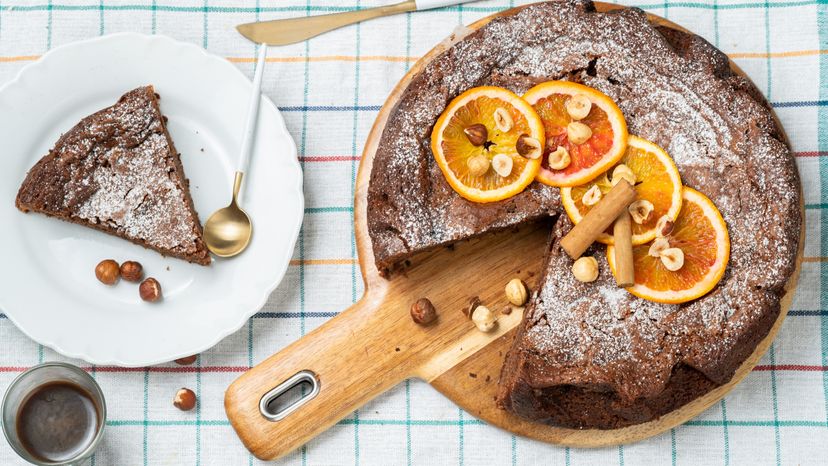In any kind of baking, a properly preheated oven is a key to success. It usually takes about twenty minutes for an oven to reach the desired temperature, so be sure to allow enough time. Always double-check the oven temperature with a free-standing oven thermometer. Never believe the temperature on your thermostat dial—these thermostats are notoriously unreliable.
The position of the rack is another important point. Before turning on the oven, adjust the rack to position designated for the recipe. Heat rises, and if a cake, for example, is baked n the top third of the oven, it will brown, and possibly burn, more quickly than one baked in the center rack.
Some pastry recipes require a pie to be baked on a baking sheet (it doesn't have to be nonstick) in the lower third of the oven. In a gas oven, this places the pie plate nearest the source of heat. In an electric oven, place the sheet in the center rack. You don't want the baked good to be too close to the heat source, or it will burn. The hot baking sheet gives the pie dough a flat, solid surface to bake on, which promotes and evenly browned, crisp crust and catches any drips.
When making regular cookies, some people bake two sheets at a time, switching the position of the sheets halfway through baking. This doesn't work with reduced-fat cookies, as the hot air should be encouraged to circulate to brown the cookies evenly, and the second sheet blocks the circulation. Bake cookies one sheet at a time, in the center of the oven. If you have only one baking sheet, line it with parchment paper so you can move quickly to the second batch without having to wash the sheet. However, the sheet should be cooled before using it again. Don't cool cookie sheets by rinsing them under cold water, or they could warp.
Doneness
Watch out for overbaking! It's a major cause of low-fat baking failures, whether you are baking cakes, cookies, or quick breads. Low-fat baked goods may have moist, shiny tops and look underdone, but those looks can be deceiving.
Low-fat cake baking has a different set of doneness tests from traditional baking. In full-fat baking, the most common method of testing for doneness is to insert a toothpick or a thin wire cake tester into the center of the cake. If the toothpick comes out clean without any unbaked batter clinging to it, the cake is done. The toothpick test doesn't work with reduced-fat baking, which requires other visual and tactile tests to be sure the baked good is baked through. This also holds for muffins and quick breads.
- To avoid overbaking, check for doneness at the beginning of the specified time range.
- Unless specified in the recipe, the top will spring back when gently pressed in the center.
- The edges are lightly browned and are beginning to pull away from the sides of the pan. Some quick breads will develop a large crack running down the top—it's normal.
Bake cookies until they are very lightly browned around the edges. The centers may seem underdone, but they will firm upon cooling. If the cookies cool and harden onto the sheet, return the sheet to the oven for a few seconds or so until the cookies soften (they won't stick to nonstick sheets).
Pie crusts should be baked until golden brown. If a pie crust is over-browning before the filing is done (the center should jiggle only slightly when the pie is shaken), protect the crust by covering it with strips of aluminum foil.
CoolingSome baked goods are meant to be eaten right out of the pan, and can be cooled in the pan on a wire cake rack. For cake and loaf recipes that require unmolding, place the pan on a wire cake rack and let it stand for 10 minutes. Run a knife around the inside of the pan to release the cake from the sides, then invert it onto the rack. If the loaf pan has been lined with waxed paper, carefully peel it off the loaf. Turn the loaf right side up and cool completely on the rack. A few cakes and quick breads may sink slightly in the center when cooled. When they are sliced, the indention won't be so noticeable, so don't worry about it. Cool cookies on a wire cake rack.
StorageMost reduced-fat baked goods will keep for up to two days at room temperature, wrapped in aluminum foil. Foil works better than plastic wrap or plastic bags, which hold in the moisture. (Because of the moisture-attracting properties of fruit purees, low-fat baked goods can "sweat.") However, cookies keep best in zip-tight plastic bags. You can refrigerate the baked goods if you wish, but most of them are best if served at room temperature. Well wrapped in aluminum foil and placed in a zip-tight bag, they can also be frozen for up to two months. Always cool baked good completely before storing. Store all frosted cakes, cheesecakes, and pies in the refrigerator.
